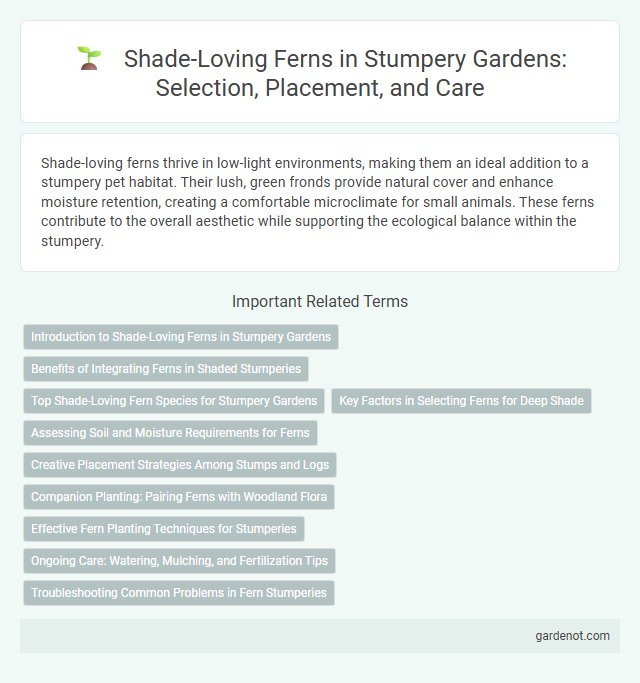Shade-loving ferns thrive in low-light environments, making them an ideal addition to a stumpery pet habitat. Their lush, green fronds provide natural cover and enhance moisture retention, creating a comfortable microclimate for small animals. These ferns contribute to the overall aesthetic while supporting the ecological balance within the stumpery.
Introduction to Shade-Loving Ferns in Stumpery Gardens
Shade-loving ferns thrive in the cool, damp microclimates created by stumpery gardens, where decaying wood provides rich nutrients and moisture retention. These ferns, including species like Athyrium niponicum and Polystichum munitum, contribute lush, textured greenery that contrasts with the rugged wood elements. Their adaptability to low-light conditions makes them essential for enhancing biodiversity and aesthetic appeal in shaded garden spaces.
Benefits of Integrating Ferns in Shaded Stumperies
Shade-loving ferns thrive in the cool, damp environments of shaded stumperies, enhancing biodiversity by providing habitat for various insects and small wildlife. Their lush, intricate fronds contribute to soil moisture retention and prevent erosion around decaying wood, promoting healthier microecosystems. Integrating ferns in shaded stumperies also adds textural contrast and year-round greenery, enriching the visual appeal and ecological function of woodland garden spaces.
Top Shade-Loving Fern Species for Stumpery Gardens
Top shade-loving fern species for stumpery gardens include Athyrium filix-femina (lady fern), Dryopteris erythrosora (autumn fern), and Polystichum munitum (western sword fern). These ferns thrive in low-light conditions and contribute lush, feathery foliage that complements the rugged texture of decaying wood. Their adaptability to moist, shaded environments makes them ideal for creating a naturalistic, woodland atmosphere in stumpery landscapes.
Key Factors in Selecting Ferns for Deep Shade
Shade-loving ferns such as the Christmas fern (Polystichum acrostichoides) and the maidenhair fern (Adiantum) thrive in deep shade by requiring consistent moisture, well-drained soil, and high humidity to prevent frond desiccation. Selecting ferns with adaptive traits like tolerance to low light conditions and resistance to fungal diseases ensures longevity and vigor in shaded garden areas. Soil rich in organic matter and protection from strong winds further promotes healthy growth and vibrant foliage in these shade-adapted species.
Assessing Soil and Moisture Requirements for Ferns
Shade-loving ferns thrive best in well-draining, humus-rich soil that retains consistent moisture without becoming waterlogged, ensuring optimal root health. Evaluating soil pH is crucial, with most ferns preferring slightly acidic to neutral conditions between 5.5 and 7.0. Regularly monitoring soil moisture through touch or moisture meters helps maintain the delicate balance ferns need to flourish in shaded stumpery environments.
Creative Placement Strategies Among Stumps and Logs
Shade-loving ferns thrive in the moist, sheltered microhabitats created by stumps and logs, offering unique opportunities for creative placement in stumperies. Positioning these ferns on the decaying wood surfaces enhances moisture retention and mimics their natural forest floor environment, promoting vigorous growth. Integrating varied stump heights and moss-covered logs fosters a layered, textured landscape that highlights the delicate fronds while supporting biodiversity.
Companion Planting: Pairing Ferns with Woodland Flora
Shade-loving ferns thrive when paired with companion woodland plants such as hostas, astilbes, and trilliums that complement their texture and enhance the stumpery's naturalistic aesthetic. These companion plants benefit from similar moisture and soil acidity preferences, creating a harmonious microenvironment ideal for growth. Integrating diverse foliage shapes and blooming times enriches the visual appeal while supporting biodiversity in shaded garden settings.
Effective Fern Planting Techniques for Stumperies
Shade-loving ferns thrive in stumperies by planting them in well-drained, humus-rich soil that retains moisture without waterlogging. Position ferns in sheltered spots with dappled sunlight or full shade to mimic their natural woodland habitat, promoting lush growth. Incorporating organic mulch around the base helps maintain soil humidity and suppress weeds, ensuring healthy, vigorous fern development.
Ongoing Care: Watering, Mulching, and Fertilization Tips
Shade-loving ferns in a stumpery require consistent moisture without waterlogging, making well-drained, humus-rich soil essential for optimal growth. Applying a layer of organic mulch such as leaf mold or pine needles helps retain soil moisture, suppress weeds, and regulate temperature fluctuations. Regular fertilization with a balanced, slow-release fertilizer in early spring supports healthy frond development and enhances the fern's resilience in shaded, woodland-inspired environments.
Troubleshooting Common Problems in Fern Stumperies
Shade-loving ferns in stumperies often face issues such as yellowing fronds caused by overwatering or poor drainage, and browning tips resulting from low humidity or inadequate shade. To troubleshoot, ensure soil remains consistently moist but well-drained, and place the stumpery in a location with filtered light and high humidity. Regularly inspect for pests like scale insects or aphids, which can weaken ferns and stunt their growth.
Shade-loving fern Infographic

 gardenot.com
gardenot.com